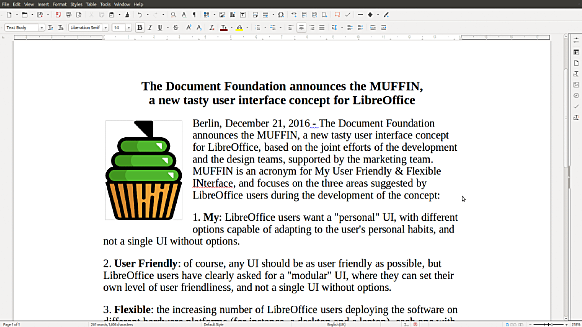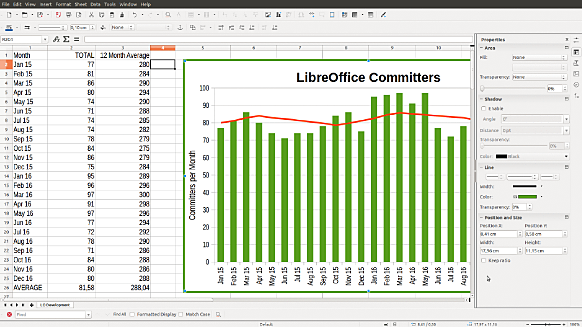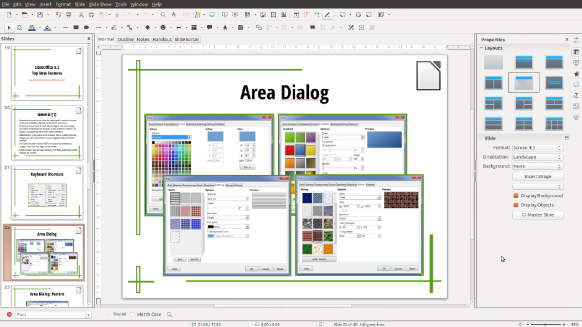LibreOffice 5.3 Open Source Productivity Suite Major Upgrade Released With New Online Cloud Office Suite Option
The Document Foundation has announced Version 5.3 of its open source LibreOffice productivity software suite, calling it one of the most feature-rich releases in the history of the application. The LibreOffice 5.3 office suite is immediately available for Windows, macOS, and Linux, and for the first time also online for the private cloud.
LibreOffice 5.3 represents a significant step forward in the evolution of the software, offering an introduction to new features such as online with collaborative editing, which increase the application’s competitive positioning and at the same time provides incremental improvements, to make the program more reliable, interoperable and user-friendly.
“LibreOffice is backed by a fantastic community of developers,” says Michael Meeks, a member of the board of The Document Foundation. “In 2010, only a few people were betting on our capability of attracting a large number of code contributors, which are instrumental for the success of a large code base. In six years we have attracted over 1,100 new developers and, thanks to this large community, during the last two years we have had an average of 300 people active on the source code.”
LibreOffice 5.3 highlights
LibreOffice 5.3 offers a number of interesting new features in every module: a new cross-platform text layout engine that uses HarfBuzz for consistent text layout on all platforms, with significant advantages across languages and alphabets; a revised Help menu, with new quick links to user guides and community support forums, for an improved user experience; and better import/export filters to new and legacy MS Office documents.
Writer now supports Table Styles, for applying formatting to a table which is preserved when you make edits to it; a new Page Deck in the sidebar lets the user quickly customise page settings without having to go through a separate dialog box; and a new Go to Page Box makes it possible to jump to another page in the document with just a few keystrokes.
Calc provides a new set of default cell styles, with greater variety and better names than in previous releases; in fresh installations, Enable wildcards in formulas is now the default option, rather than regular expressions, to improve compatibility with other spreadsheet software; and a new text entry box lets the user narrow down the functions he is looking for, and simplifies the search for the right one.
Impress now opens with a template selector, to get the user off to a quick start; and a new Slide Properties Deck is now available in the sidebar while in slide master mode.
A list of the most significant new features is available at http://tdf.io/lo53features, and is presented in a series of short videos (http://tdf.io/53vids). A page with the top new features is also available on the website at http://www.libreoffice.org/discover/new-features/.
LibreOffice 5.3 has also been improved under the hood, thanks to the work of hundreds of volunteers. This translates into an open source office suite which is easier to develop, maintain and debug. Although this is not visible to users, it is extremely important for enterprise deployments.
LibreOffice is deployed by large organizations in every continent. A list of the most significant migrations announced in the media is available here: https://wiki.documentfoundation.org/LibreOffice_Migrations.
LibreOffice Online
LibreOffice 5.3 also features the first source release of LibreOffice Online, a cloud office suite which provides basic collaborative editing of documents in a browser by re-using the LibreOffice core engine. Rendering fidelity is excellent, and interoperability matches that of LibreOffice.
LibreOffice Online is fundamentally a server service and should be installed and configured by adding a cloud storage and an SSL certificate, which are not included in the solution. It might be considered an enabling technology for the public cloud of ISPs or the private cloud of enterprises and large organizations.
Builds of the latest LibreOffice Online source code are available as Docker images: https://hub.docker.com/r/libreoffice/online/.
A background document providing the positioning of LibreOffice Online is available here: http://tdf.io/loonlineback.
Experimental UI features
Starting from the 5.3 family, LibreOffice UI has been extended with the addition of an experimental Notebookbar, which offers another UI option in addition to the Default UI (with two toolbars), the Single Toolbar UI and the Sidebar with a Single Toolbar. Each UI layout has been thought to serve a different cluster of LibreOffice users.
LibreOffice UI is code named MUFFIN, an acronym for My User-Friendly & Flexible INterface. A background document explaining the UI concept is available here: http://tdf.io/muffinback.
Availability And Enterprise Deployments
LibreOffice 5.3 represents the bleeding edge in term of features for open source office suites, and as such is targeted at technology enthusiasts, early adopters and power users.
For enterprise class deployments, TDF maintains the more mature 5.2.5 version, which should be supported by certified professionals according to best practices recognized worldwide (http://www.libreoffice.org/get-help/professional-support/).
LibreOffice 5.3 is immediately available from the following link: http://www.libreoffice.org/download/. LibreOffice users, free software advocates, and all community members can support The Document Foundation with a donation at http://donate.libreoffice.org.
Source: The Document Foundation



